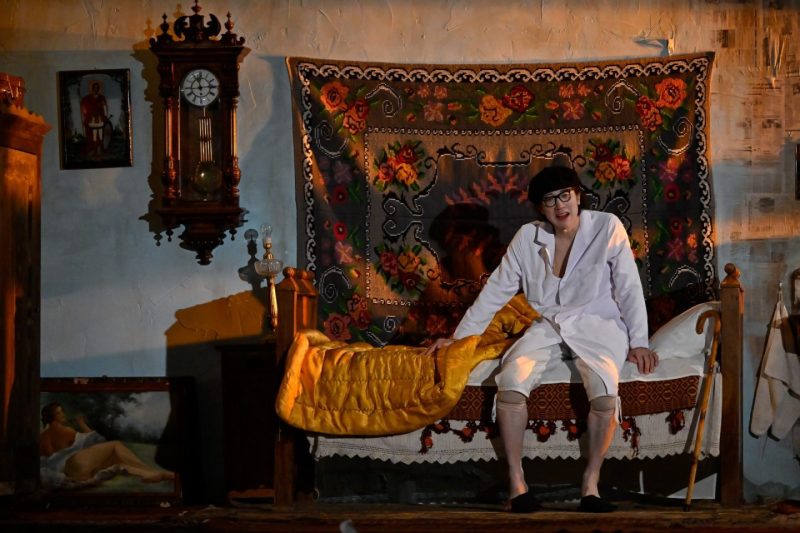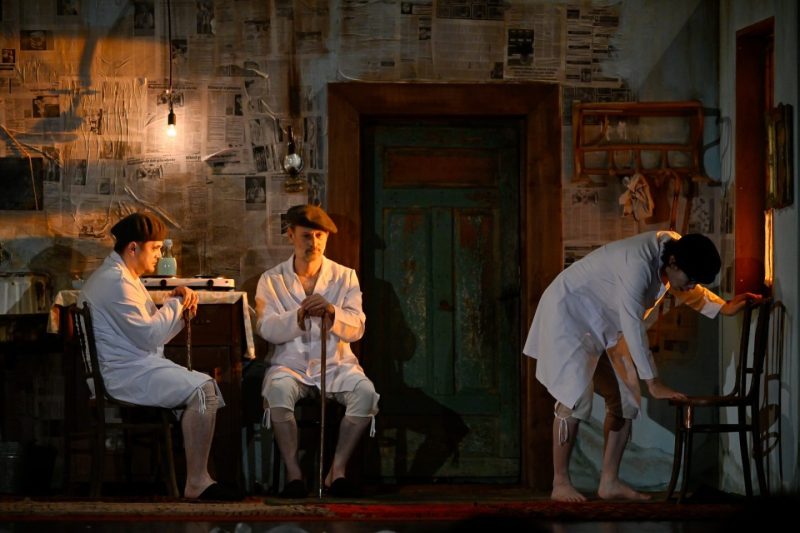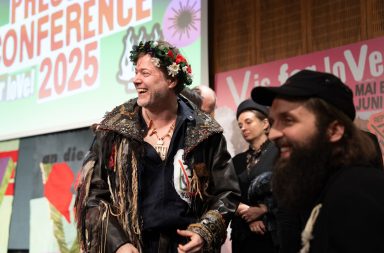„Japan is another planet”, stated Silviu Purcărete, following his first visit to the Land of the Rising Sun. On this occasion, he produced Richard III (2017) and A Midsummer Night’s Dream (2020) for the Tokyo Metropolitan Theatre, as well as The Scarlet Princess (2018) in Sibiu. I recall The Scarlet Princess since, following the import and adaptation of kabuki theatre for the Romanian audience, this Romanian-Japanese cultural exchange was expected to go both ways. Therefore, Silviu Purcărete’s most recent premiere for the “Radu Stanca” National Theatre Sibiu features Kuranosuke Sasaki as Iona, the character in the play with the same name by Marin Sorescu.

Why Marin Sorescu? Why such a „vernacular” author, with all the language characteristics so much connected with the Romanian space in a product that aims precisely at a universal approach of the artistic message, some „detachment” of the literary speech? It might be due to the parable substrate of Iona’s story. Despite its biblical Christian background (rather unknown to the Japanese Shinto-Buddhist sensitivity), it intimately and universally speaks about the relationships of the human being with the sacred, as well as the urge to connect with nature, against the endless waters and creatures who inhabit those places. Or, not to leave the psalms’ stylistic universe, against the sea, that „dragon you made to play within” – the haunting terror-fascination of the world’s great cultures, such as Shachihoko monster in the Japanese mythology.
To win this intercultural bet, it was therefore absolutely necessary for Silviu Purcărete to choose a relevant text for two such different cultures, one „meteor” to cross the gravitational fields of the two „planets” (Romania – Japan), in an attempt to express one truth transcending all semantic and style characteristics. However, we know that Iona summarizes, on the one hand, the tragic ancestral relations between man and divinity, reminiscent of Oedipus’ curse, for instance.
His tragic guilt poisons the fortress where he lives, the same as Iona’s guilt threatens to sink the boat he takes refuge in to escape from Nineveh. On the other hand, we must not forget other modern, more mainstream variations of this parable, such as Carlo Collodi’s novel, Pinocchio in which Gepetto, in pursuit of his son in whom the divine breath animating the matter manifests itself, is swallowed by a whale. To that end, Iona seemed like the natural choice. It developed organically into a spectacular product preserving familiarity and strangeness with equal intensity.

Like so many other iconic directors of the 20th century and nowadays, Silviu Purcărete is a fundamental creator. To him, the primary materiality of water, fire, wood, earth and sand is not merely a purely visual background, but also a symbolic matter turning the diegesis of the performance into a transcendental experience. Let us recall, for example, the mineral, dusty brutalism, with fire outbursts of the famous Faustus. Or the fundamental symbiosis of water, fire and the atmospheric environment in Metamorphosis. Or even the ethereal, floral, vegetal consistency of female characters in The Scarlet Princess, counterpoint to the metallic excesses of male characters.
Iona is no exception to this aesthetic principle. However, on the level of stage materiality, the water landscapes of Sorescu’s play are captured in a metaphorical key of a purism that is rarely encountered in the director’s work. Hence, the four plans of this „tragedy”, as Marin Sorescu himself calls it, cross different spaces, from the beginning when Iona fishes against a white paper wall, to the last scene, that of „the awakening to reality” from the existentialist (aquatic, placental) dream of a Iona consumed with aging and mental collapse.
In an aesthetic key starting from the minimalism of the beginning to the photographic authenticity of the rural domestic setting at the end, set designer Dragoș Buhagiar imagines as concentric circles, those fish bellies evolving from the weightlessness of bodies, sounds and marine vibrations to the earthly harshness of human decay. The rustle of paper on which the water waves caressed by currents and the soft hissing of plastic bags imagining underwater creatures are projected, together with recurrent interventions of an echoing voice performing passages from David’s Psalms in Japanese, arranged by Vasile Șirli, complement each other in an evanescent acoustic-musical world that gradually becomes a vortex, a final „breakthrough to the light” of the hero from the tentacles of his own chimera.

Oscillating between monotony and sudden outbreaks of emergency, Kuranosuke Sasaki demonstrates stage intelligence and precision. Both established him in Japan as one of the leading actors in his generation. The emotional note of his monologue from Sorescu is definitely a key factor in the performance cohesion. He succeeds to surprise a fine mix between tempered seriousness, sometimes neurotic physicality, and the childish foolery of a character in search of himself. He is joined on stage by the actors of the National Theatre Sibiu – Veronica Arizancu, Liviu Vlad and Eduard Pătrașcu. Their rather unearthly presence resumes Purcărete’s well-known obsession with collective characters and tableaux vivants. Both angelic and demonic, these ghostly creatures become either caricatured alter egos of the main hero, or picture embodiments of destiny, ultimately depicting a tender memento mori that precedes Iona’s final exit out of the stage.
Quite unusual, if compared with the other performances that established Silviu Purcărete in the theatre space of Sibiu (perhaps the closest parallel would be Waiting for Godot from 2005), Iona may be an experience that does not easily unravel to the audience. Implosive, contemplative, but at the same time either rhetorical or ironic, the performance requires patience and self-reflection, as it revisits Sorescu’s playwriting masterpiece, to embody a meditation on human transience.
Translation: Camelia-Maria Tuță; Credit photo: Dragoș Dumitru


